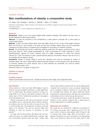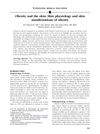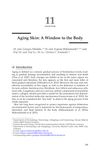Dermatological Problems in Children with Obesity
March 2013
in “
Bundesgesundheitsblatt - Gesundheitsforschung - Gesundheitsschutz
”
obesity skin barrier sebaceous gland activity psoriasis pseudoacanthosis nigricans fibroma pendulans striae distensae hyperandrogenism acne vulgaris hirsutism androgenetic alopecia pro-inflammatory factors adipose tissue erysipelas intertrigo skin infections skin conditions hair loss acne obesity-related hair loss
TLDR Obesity in children can worsen skin issues and increase infection risk.
The document discussed the dermatological issues associated with obesity in children, highlighting that while the effects of obesity on cardiovascular and metabolic diseases were well-studied, its impact on the skin was less explored. Obesity was found to alter the skin barrier, affect sebaceous gland activity, and exacerbate existing skin conditions such as psoriasis. Common skin manifestations in obese individuals included pseudoacanthosis nigricans, fibroma pendulans, and striae distensae. In females, obesity-related hyperandrogenism could lead to acne vulgaris, hirsutism, and androgenetic alopecia. The study also noted a pathogenic link between obesity and psoriasis, with pro-inflammatory factors from adipose tissue worsening psoriasis, and a correlation between psoriasis severity and body mass index. Additionally, obesity increased the risk of skin infections like erysipelas and intertrigo.





